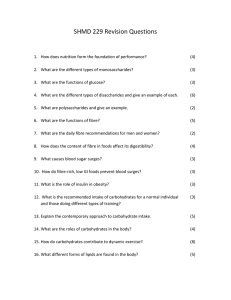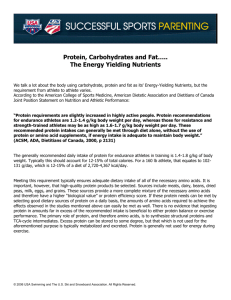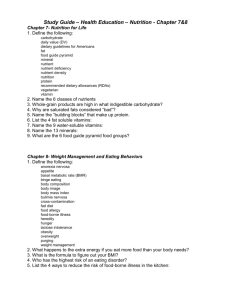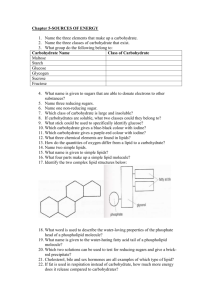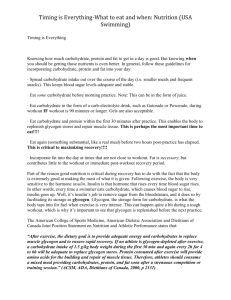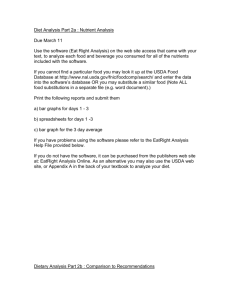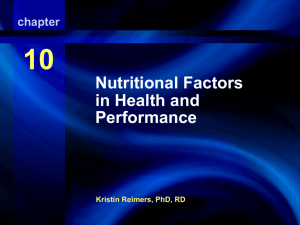chapter - Human Kinetics
advertisement
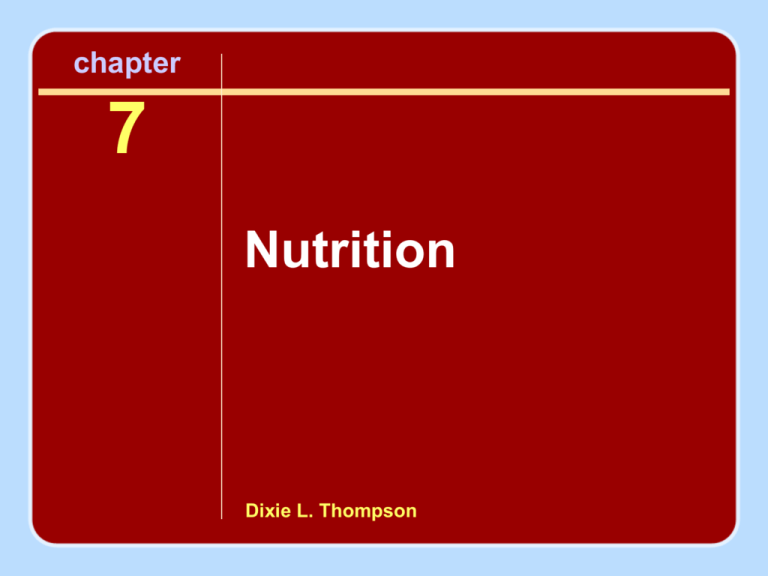
chapter 7 Nutrition Dixie L. Thompson Important Terms • • • • • Dietary Reference Intake Recommended Dietary Allowance Adequate Intake Tolerable Upper Intake Levels Acceptable Macronutrient Distribution Range Six Classes of Nutrients • • • • • • Carbohydrate Fat Protein Vitamins Minerals Water Carbohydrate • Glucose (C6H12O6) is the most important simple sugar in the body. • The primary storage form of carbohydrate in the body is glycogen. • Carbohydrate should be chosen based on nutrient density. • Dietary fiber is another important consideration when choosing forms of carbohydrate. • Glycemic index is used to describe how quickly a food elevates the blood glucose level after ingestion. Fat Important terms – – – – – – – Triglycerides Phospholipids Cholesterol Lipoproteins Saturated fats Unsaturated fats Trans fats Protein • • • • Amino acids combine to form proteins. Protein serves a variety of roles in the body. There are eight essential amino acids. Ingesting 0.8 g of protein per kilogram of body weight is generally adequate for supplying the body’s needs. • Protein can be supplied by both meat and vegetarian selections. However, with a vegetarian diet, care should be taken to consume complementary proteins. AMDR for Fat, Carbohydrate, and Protein Created from Food and Nutrition Board, Institute of Medicine, 2002, Dietary reference intakes for energy, carbohydrates, fiber, fat, fatty acids, cholesterol, protein, and amino acids (Washington, DC: National Academies Press). Vitamins • Vitamins are organic substances essential to the normal functioning of the human body. • Fat-soluble vitamins are A, D, E, and K. • Water-soluble vitamins are B and C. • Antioxidant vitamins are thought to help ward off disease. Beta-carotene, vitamin C, and vitamin E are often praised for their antioxidant qualities. Minerals • Minerals are inorganic elements that serve a variety of functions in the human body. • American adults consume inappropriate amounts of calcium, iron, and sodium. Minerals: Calcium • Calcium is a mineral often ingested in inadequate amounts by Americans. • Adequate Ca2+ promotes bone health and can prevent osteoporosis. • Dairy products, dark green vegetables, and some nuts are good sources of Ca2+. Minerals: Iron • Many Americans underconsume iron, leading to iron-deficiency anemia. • Men and postmenopausal women should ingest 8 mg of iron each day • Premenopausal women should ingest 18 mg of iron each day. • Good sources of iron are red meat and eggs and vegetarian sources such as spinach, navy and lima beans, and prune juice. Minerals: Sodium • Sodium is a mineral that many Americans overconsume. • Sodium is found in most processed foods. • Sodium intake should be limited to no more than 2,300 mg a day. Water • A person should ingest 1 to 1.5 ml of water for each kilocalorie expended each day. • The AI for men is 3.7 L · day–1 and for women is 2.7 L · day–1. Dietary Assessment • Food logs can be useful in learning about a person’s food intake. • Clients should be educated about how to properly complete food logs. • Although a registered dietitian should be consulted for specific dietary analysis and instruction, a fitness professional who is not a dietitian can often provide general information on healthy eating. Food Guide Pyramid Reprinted, by permission, from V. Heyward, 2006, Advanced fitness assessment and exercise prescription, 5th ed. (Champaign, IL: Human Kinetics), 235. MyPyramid from www.mypyramid.gov. Daily Values • Daily values are used in food labeling to help consumers understand the nutritional quality of foods. • Food labels must contain information about total calories, fat (including saturated fat), cholesterol, sodium, carbohydrate (including dietary fiber), protein, and various vitamins and minerals. Lipoproteins and CVD Risk: Understanding Cholesterol It is important to differentiate – HDL-C, – LDL-C, and – total cholesterol. 2001 NCEP Guidelines for Ideal Values • Total cholesterol < 200 mg · dL–1 • LDL-C < 100 mg · dL–1 • HDL-C > 60 mg · dL–1 Therapeutic Lifestyle Changes (TLC) Diet • Established by the NCEP • Includes the following: – Limiting total fat intake to 25% to 35% of calories – Limiting saturated fat intake to 7%, polyunsaturated fat intake to 10%, and monounsaturated fat intake to 20% of calories – Limiting cholesterol intake to < 200 mg · day–1 – Limiting intake of trans fats Hydration for Exercise • 14 to 20 oz (350-600 ml) of water 2 hr before exercise • 7 to 10 oz (200-300 ml) 10 to 20 min before exercise • 6 to 12 oz (150-350 ml) every 15 to 20 min during exercise • 16 to 24 oz (475-700 ml) of fluid after exercise for every pound (0.45 kg) of weight lost Protein Intake for Athletes • Aerobic athletes who are training intensely may benefit from consuming 1.2 to 1.4 g of protein for each kilogram of body weight. • A protein intake of 1.6 to 1.7 g per kilogram of body weight may be needed for athletes engaging in high-intensity, high-volume resistance training. • Protein intake is best obtained via a healthy diet rather than amino acid supplements. Ergogenic Aids • Some products are not usually harmful but provide no athletic edge. • Some provide an edge but are banned by regulatory agencies. • Some lead to health risks that far outweigh any potential increase in performance. (continued) Ergogenic Aids (continued) • Higher-than-RDA levels of vitamins and minerals do not appear to provide a competitive edge. • Creatine phosphate is a high-energy compound that may enhance high-intensity exercise performance. Long-term effects of its use are unknown. Carbohydrate and Athletes • Generally, athletes should obtain 60% to 65% of their calories from carbohydrate. • A diet containing 6 to 10 g of CHO per kilogram of body weight is recommended for athletes engaging in frequent, exhaustive bouts of exercise. • During long bouts of exercise, ingestion of solutions containing 4% to 8% carbohydrate (150-350 ml every 15-20 min) can help maintain blood glucose concentration. Carbohydrates and Athletes: Carbohydrate Loading • In preparation for competition, carbohydrate loading can be useful. • Carbohydrate loading consists of tapering activity and ingesting large amounts of CHO in the days leading up to competition. Female Athlete Triad • Female athlete triad is a condition characterized by disordered eating, amenorrhea, and osteoporosis. • See chapter 17 for more information.
